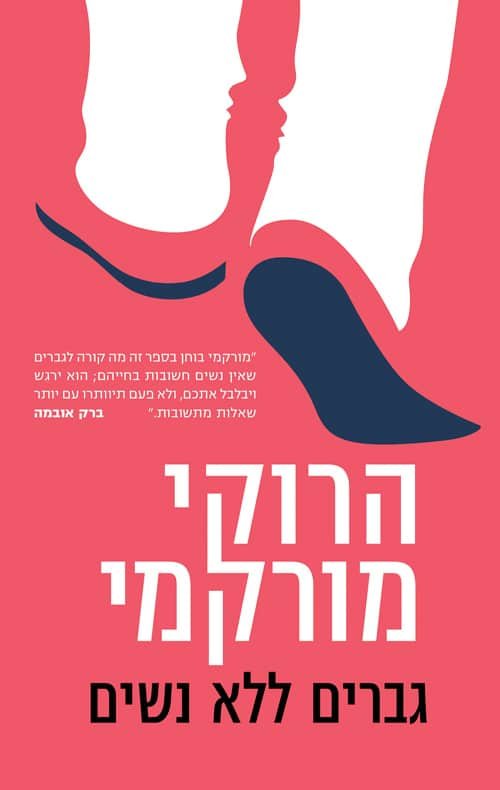For English review, please scroll down.
אסופת שבעה סיפורים קצרים שעוסקים בגברים בודדים, נבגדים, עזובים ופגועים. רובם טובים מאוד, שני סיפורים מצויינים.
"אתה שטיח פרסי בצבע בהיר, ובדידות היא כתם יין־בורדו שלא יורד."
בסיפור הפותח את האסופה – "תנהגי במכונית שלי" – קאפוקו, שחקן תאטרון, מפתח עיוורון ולכן התאטרון מכריח אותו לשכור נהגת. במהלך הנסיעות המשותפות שלהם, הוא מספר לה את סיפור אהבתו לאישתו המתה, שחקנית בינונית בסרטים, יפיפיה מסחררת, שניהלה רומאנים חולפים עם גברים צעירים שפגשה על סט הצילומים.
לאחר מותה, קאפוקו פוגש במאהב האחרון שלה, שחקן שהתאהב בה עד שיגעון, במטרה לנקום בו. אבל במהלך הפגישה, הלך הרוח שלו משתנה ובלי שהתכוון לכך, הבחור מצא חן בעיניו.
סיפור מדכדך שמתווה את הקו של יתר הסיפורים באסופה. יש משהו פאטלי בגורל הגברים שמורקמי מתאר: הסדר הטבעי מופר כאשר האישה אינה נוכחת בחיי הגבר. חיי הגברים נעצרים, הזמן קופא, כמו מטוטלת שמפסיקה לנוע.
בסיפור השלישי באסופה, אחד מהמצויינים שבה – "איבר עצמאי" – הפטליזם מגיע לשיאו:
טוקאי, מנתח פלסטי שניהל מרפאה מצליחה לאסתטיקה, היה הרווק הנצחי. לאורך שנים הוא ניהל במקביל מספר מערכות יחסים שטחיות עם נשים נשואות. המספר, חברו לסקווש, מדייק ואומר "טוקאי תמיד שימש מאהב מספר שתיים , מזדמן…"
טוקאי מתנהל באותה הדרך במשך שלושים שנה, עד שגורלו מפגיש אותו עם אישה צעירה נשואה, שבה הוא מנסה בכל כוחו לא להתאהב. רק אחרי המפגש איתה, הוא קולט עד כמה לא היה שלם כאדם.
מערכת היחסים הזו מובילה את טוקאי להרהר בשאלות קיומיות ביחס לעצמו ולחייו. הוא מסתובב במעגלים סביב עצמו ולא מגיע לתשובה.
אט- אט חייו של טוקאי מקבלים תפנית. בהתחלה הוא מפסיק לאכול צהרים, הפסיק ללכת למכון הכושר, הפסיק להיפגש עם נשים בזמנו החופשי. הוא שוקע בדיכאון, ואיבד את התאבון הוא הולך ומצמצם את עצמו עד מוות.
לטעמי, הסיפור הטוב ביותר בקובץ הוא "סמסא מאוהב" – הסיפור מרפרר ל"גילגול" מאת קפקא עם היפוך וטוויסט מעניין: אם גרגור סמסא הפך מאדם לג'וק, זה של מורקמי הופך מחרק לאדם.
"הזה באמת הוא? האם יכול גוף בלתי סביר כל כך, שקל כל כך להשמידו (בלי שריון להגנה, בלי כלי נשק להתקפה), לשרוד בעולם? מדוע לא נהפך לדג? או לחמנייה? בדג או בחמנייה יש היגיון. על כל פנים, היגיון רב יותר מאשר ביצור הזה, גרגור סמסא. לא היתה שום דרך אחרת להסתכל על זה."
תהליך הגילוי נבנה בשלבים ומגיע לשיאו בתשוקה שהוא חש כלפי מתקנת המנעולים הגיבנת:
"סמסא עמד מאחוריה וצפה בה מתנועעת כך, ופתאום החל גופו להגיב בצורה מוזרה. הוא נתקף כולו חום,"ונחיריו התרחבו. פיו היה יבש והפיק לִעלוע רם כל אימת שבלע. תנוכי אוזניו גירדו. ואיבר המין שלו, שהשתלשל במין רפיון מוזר עוד לאותו הרגע, החל להתקשות ולהתארך. בשעה שהזדקר הופיעה תפיחה בחזית החלוק. אלא שלא היה לו שמץ של מושג מה זה עשוי לסמן."
המטמורפוזה של גרגור סמסא והגילויים שנלווים לה, מתרחשים בזמן שבחוץ מתרחשת הפיכה צבאית וטנקים שוטפים את רחובות פראג. הכאוס בחוץ משתווה כמעט לכאוס שגרגור סמסא חש לנוכח גופו האנושי, מחשבותיו האנושיות והצורך שלו בחברתה של מתקנת המנעולים, שהיא מבחינתו על תקן הנביאה של הבשורה.
כל הסיפורים בקובץ מלמדים על כמיהה עזה לקשר זוגי ולאהבה. בחיי הגיבורים חסר משהו בסיסי כשהם חווים אובדן של הקשרים הזוגיים, או היעדרם. ברקע מרחף הדיכדוך והיאוש שעוטף את הגיבורים הבודדים.
כפי שכתבתי, רוב הסיפורים באסופה טובים מאוד ושניים מהם, לטעמי, מצויינים. מומלץ לקרוא רק בכדי לפגוש את גרגור סמסא המבולבל והנבוך של מורקמי.
גברים ללא נשים/ הרוקי מורקמי
הוצאת כנרת זמורה דביר, כתר, 2021, 368 עמ'
דירוג SIVI –
איכות אודיו –

A collection of seven short stories delving into the emotional depths of lonely, betrayed, abandoned, and hurt men. Most of them are very good, two excellent stories.
In the story that opens the gathering – "Drive my car" – Kapoko, a theater actor, develops blindness, and therefore, the theater forces him to hire a driver. During their joint travels, he tells her the story of his love for his dead wife, a mediocre actress in movies, a dizzying beauty who had fleeting affairs with young men she met on the set.
After her death, Kapoko meets her last lover, an actor who fell madly in love with her, with the aim of revenge on him. But during the meeting, his mindset changes, and without meaning to, the guy takes a liking to him.
This story outlines the themes of the other stories in the collection. Murakami describes a fatalistic view of men's lives: the natural order is disrupted when a significant person, regardless of gender, is absent. Lives stagnate, and time seems to stand still like a pendulum that has ceased to swing.
In the third story in the collection, one of the best of it – "Independent Organ" – fatalism reaches its peak:
Tokay, a plastic surgeon who ran a successful aesthetic clinic, was the eternal bachelor. Over the years, he had several superficial relationships with married women. The narrator, his squash friend, is accurate and says, "Tokai has always been a number two lover, a casual…"
Tokai's life remained unchanged for thirty years until fate brought him together with a young married woman. He tried his best not to fall in love, but meeting her made him realize how incomplete he was, inspiring a transformative journey.
This relationship leads Tokai to ponder existential questions regarding himself and his life. He goes around in circles around himself and needs help to reach the answer.
Slowly, Tokai's life takes a turn. At first, he stopped eating lunch, stopped going to the gym, and stopped seeing women in his free time. He sinks into depression, and having lost his appetite, he shrinks himself to death.
In my opinion, the best story in the collection is "Samsa in Love." It is reminiscent of Kafka's "Incarnation" with an exciting reversal and twist: if Gregor Samsa turned from a man into a cockroach, Murakami turned from an insect to a man.
The discovery process is built in stages and culminates in the passion he feels for the hunchbacked locksmith:
Gregor Samsa's metamorphosis and the accompanying revelations occur amidst a military coup outside, with tanks sweeping the streets of Prague. The external chaos mirrors the internal turmoil that Gregor Samsa feels in the face of his human body, his human thoughts, and his need for the company of the locksmith, who, for him, is akin to a prophet.
All the stories in the collection resonate with the intense longing for a relationship and love. When the heroes experience the loss of their marital ties or their absence, something fundamental is missing in their lives. In the background, the despondency and despair surrounding the individual heroes hovers, creating a sense of connection with the audience.
לגלות עוד מהאתר Sivi's Books
Subscribe to get the latest posts sent to your email.

